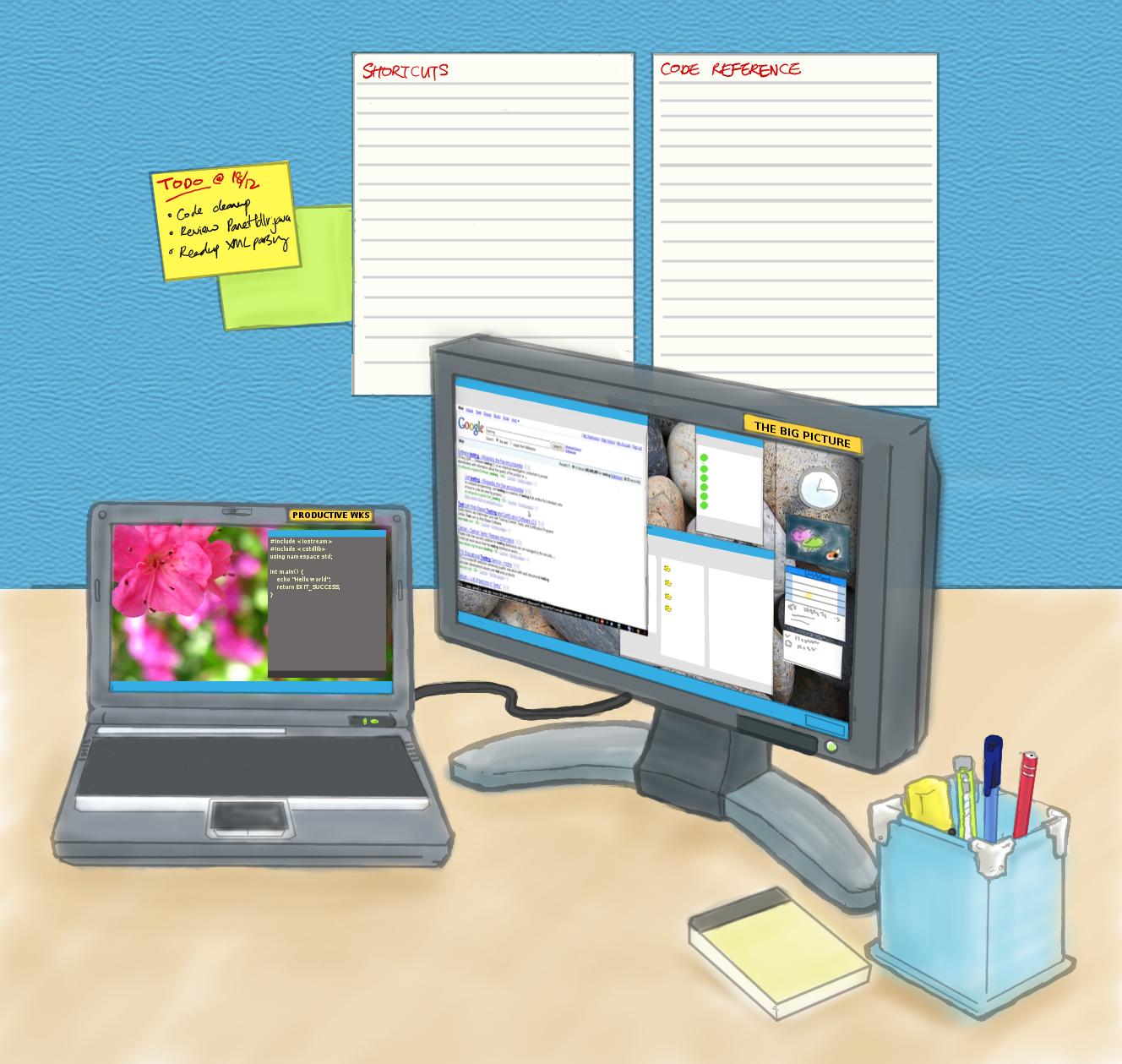High productive workspace setup with dual monitors

A month ago, I’m lucky to receive a 24” monitor to be used with my current laptop at work. Having heard about the raves of productivity increment of a multi-monitor setup first from the [late Randy Pausch’s (of “The Last Lecture” fame) Time Management lecture][timemgt], I was quite excited with the prospect of getting that productivity boost. As it turns out, having two monitors is just the first step - Knowing how to effectively use the setup is one that I have spent quite some time to experiment to get it right and starting to notice the convenience and improvement gains.
So , the whole point of this post is to share with you my own personal workspace setup which works for me, which I believe would help you to not only help you to exploit the usefulness of multi-monitors setup but also how I setup my office desk which I find had increased my performance by minimizing distractions and utilize the rights tools (pen and paper included).
First of all, let’s talk specifically about my dual monitor setup. You can see from the illustration above1, I have a 15” notebook and a 24” external, wide-screen LCD monitor. What I do with them is that I have my laptop monitor to act as my “main” monitor on which I do all my productive work on; while the wide-screen acts as my supplementary monitor. The reason of picking a smaller monitor as the main monitor is very critical: the lack of screen real estate actually would promote the habit of keeping your open application to a minimum - giving you a strong means to focus on the work you are doing.
As for the large 24” monitor, I intimately call it the “The Big Picture” monitor: having a large monitor is crucial to be able to lay out several applications side by side. Typically I have my web browser (mainly to show up my references), email client, chat client and a widget sidebar (e.g. Vista sidebar or Google Desktop sidebar). In addition to that, the monitor should be slightly tilted diagonally in an angle that requires you to slightly swivel your seat to look at the screen for a long period of time (i.e. an angle that doesn’t make you feel comfortable to turn your head to look at it for a long period of time).
The “Big Picture” was setup purposely to only allow you to glance it: giving you a means to quickly get the most recent information on an as needed basis. Having it on the big screen also have some psychological advantages by discouraging the following time wasting habits:
- Casual surfing (Having on a big screen have the psychological dampener of the fact that your colleagues will know what you are actually surfing; the physical discomfort also dampen the urge to do so)
- Spending too much time effort checking email/chatting (having it always opened on the “Big Picture” screen would greatly reduce the urge of needing to check your mailbox; and at the same time, the physical discomfort factor to spend too much time at it)
- Having a cluttered email inbox (On big screen = possibility of public scrutiny; also enforce the habit of setting up rules to file your emails automatically for security and efficient organizing reasons)
The widget sidebar would prove to be very useful with your Big Picture monitor as you can easily stove some useful information for easy glancing purposes. At the moment I have a clock, calendar and to-do list widget on there. I also have an animated fish tank there, meant to act as a positive “distraction” when I get too worked up on something - after all, pets are good partners to calm you down, even when they are virtual ;).
It is to be noted that in case you need your web browser to do research, it’s greatly recommended that you open a new window and place it in your main “Productivity” screen - which is where it actually belongs to.
Obviously there’s so much things that you can fit into two monitors. So for most static information (as opposed to emails), exploit your cubicle walls (if you have them) to pin up these useful notes: Things that would be beneficial to have are: lists (e.g. impromptu todo lists), productivity tips that you are learning to apply and needs reminding (e.g. keyboard shortcuts or some reminders) and inspiration material (e.g. personal mission statements, quotes etc.).
And last but not least, ALWAYS have pen and paper within your reach when you are working on your computer. It’s much faster to capture information that way, especially things that flashes in your brain.
So there you have it, my own workspace setup and design. I have also prepared a quick reference sheet for this article, feel free to download and see whether it works for you :).
What’s your most productive workspace setup? Would love to hear about your productive workplace setup :).

-
My company has a strict policy of not allowing staff to take pictures, hence the illustration which accurately depicts a part of my office desk [timemgt]: http://www.youtube.com/watch?v=oTugjssqOT0 ↩